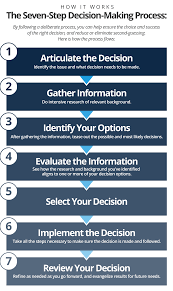Decision Making Model Examples
Decision making is a crucial aspect of our daily lives, whether it’s choosing what to have for breakfast or making important business decisions. Having a structured decision-making model can help streamline the process and lead to better outcomes. Here are some common decision-making models:
Rational Decision Making Model
The rational decision-making model involves identifying the problem, generating alternative solutions, evaluating those alternatives, and selecting the best one based on logical reasoning and analysis.
Bounded Rationality Model
In this model, decision makers are limited by their cognitive abilities and available information. They aim to make a satisfactory decision rather than an optimal one due to time and resource constraints.
Intuitive Decision Making Model
This model relies on gut feelings, instincts, and past experiences to make quick decisions without extensive analysis. It is often used in situations where time is limited or information is incomplete.
Creative Decision Making Model
Creative decision making involves thinking outside the box, exploring innovative solutions, and taking risks to achieve unique outcomes. This model encourages unconventional thinking and experimentation.
Collaborative Decision Making Model
In collaborative decision making, multiple stakeholders are involved in the process to ensure diverse perspectives are considered. This model promotes teamwork, consensus-building, and shared responsibility for the final decision.
Each of these decision-making models has its own strengths and weaknesses, and the most appropriate model will depend on the nature of the decision at hand. By understanding these models and their applications, individuals and organizations can improve their decision-making processes and achieve better results.
5 Effective Decision-Making Models: Examples and Applications
- Consider using the rational decision-making model for structured and straightforward decisions.
- For complex and uncertain situations, the intuitive decision-making model can be more effective.
- The normative decision-making model focuses on identifying the best possible alternative based on logical analysis.
- In contrast, the satisficing decision-making model involves choosing an option that is satisfactory but not necessarily optimal.
- Lastly, the incremental decision-making model involves making small adjustments or changes to existing strategies over time.
Consider using the rational decision-making model for structured and straightforward decisions.
When faced with structured and straightforward decisions, it can be beneficial to consider using the rational decision-making model. This model involves a systematic approach of identifying the problem, generating alternatives, evaluating those options based on logical reasoning and analysis, and selecting the best solution. By following this structured process, individuals can make well-informed decisions that are based on a thorough examination of all available information and potential outcomes. The rational decision-making model is particularly useful in situations where there is clear data and objectives, allowing for a methodical and efficient decision-making process.
For complex and uncertain situations, the intuitive decision-making model can be more effective.
In complex and uncertain situations where time is limited and information is incomplete, the intuitive decision-making model can be more effective. By relying on gut feelings, instincts, and past experiences, individuals can make quick decisions without extensive analysis. This model allows for flexibility and adaptability in rapidly changing environments, making it a valuable approach when faced with ambiguity and unpredictability.
The normative decision-making model focuses on identifying the best possible alternative based on logical analysis.
The normative decision-making model emphasizes the importance of identifying the best possible alternative through logical analysis. By carefully evaluating all available options and selecting the one that aligns most closely with desired outcomes, individuals can make informed and rational decisions. This model serves as a structured approach to decision making, guiding individuals towards choices that are most likely to lead to favorable results.
In contrast, the satisficing decision-making model involves choosing an option that is satisfactory but not necessarily optimal.
In contrast to other decision-making models, the satisficing decision-making model focuses on choosing an option that is deemed satisfactory rather than striving for the optimal choice. This approach acknowledges that perfect information and ideal solutions may not always be attainable, leading decision makers to settle for a solution that meets their criteria and is deemed acceptable within the given constraints. The satisficing model emphasizes practicality and efficiency in decision making, allowing individuals to make choices that are good enough rather than endlessly pursuing the best possible outcome.
Lastly, the incremental decision-making model involves making small adjustments or changes to existing strategies over time.
Lastly, the incremental decision-making model involves making small adjustments or changes to existing strategies over time. This model recognizes that decisions do not always need to be made in one big leap but can be refined gradually through incremental steps. By making small changes and assessing their impact, individuals and organizations can adapt to evolving circumstances and improve their strategies effectively. The incremental decision-making model emphasizes flexibility and continuous improvement, allowing for a more agile approach to decision making that can lead to sustainable success in the long run.




